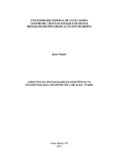| dc.creator | Tonin, Jean | |
| dc.date.accessioned | 2018-10-11T21:44:49Z | |
| dc.date.available | 2018-10-11T21:44:49Z | |
| dc.date.issued | 2017-03-20 | |
| dc.identifier.uri | http://repositorio.ufsm.br/handle/1/14538 | |
| dc.description.abstract | The present research aims to explain the fundamental aspects of the sociality of human
existence, according to Heidegger's exposition of Being and Time. In his work, starting from
the questioning of the sense of being in general, the philosopher produces an analysis of
human existence, which is systematically understood by the term being-there (Dasein). In
such analysis, the social character of existence is ontologically explained by the
characterization of the fundamental structure of existence, namely: being-with (Mitsein). In an
attempt to expose the determining characters of the being-with structure and to point out the
aspects that characterize the relationship between being-there and its similar, our research is
divided into three moments. Firstly, we will reconstruct the analysis of everyday being-there,
which requires the exposure of the introductory aspects of the work and the characterization
of the constitutive moments of the most fundamental structure of existence, there called
being-in-the-world. Further, we are able to see that on the positive exposure of the way of
being the one (das Man), which characterizes the way by which the everyday being-there is
sustained, it is verified a primacy of impropriety in existence, prompt and more often
submerged in normative patterns of behavior regulated publicly. This way of being is called
the one sociality. In the second moment, based on the description of concepts of
anguish, guilt , death and consciousness, the characters of the existential modification are
exposed, in which the being-there severs from the daily way of being and presumes to be a
fundament in the uniqueness of its existence. However, we will see that this uniqueness does
not exclude all rules and patterns, but rather departs from it, and existence relates itself
consciously and in its own way to patterns, responsively projecting into existential
possibilities, constituted inter-subjectively. In such finding, the perspective of the second
person is visible, in which it is found that the being-there is in a relationship of mutual
responsibility towards the other. Finally, based on the exposition of the temporality and
historicity of existence, we will explain how the resolute of happening (Geschehen) in the
being-there occurs in the "between" of the existential ends denominated birth and death. | eng |
| dc.description.sponsorship | Conselho Nacional de Pesquisa e Desenvolvimento Científico e Tecnológico - CNPq | por |
| dc.language | por | por |
| dc.publisher | Universidade Federal de Santa Maria | por |
| dc.rights | Attribution-NonCommercial-NoDerivatives 4.0 International | * |
| dc.rights.uri | http://creativecommons.org/licenses/by-nc-nd/4.0/ | * |
| dc.subject | Socialidade | por |
| dc.subject | Ser-com | por |
| dc.subject | Existência | por |
| dc.subject | Heidegger | por |
| dc.subject | Sociality | eng |
| dc.subject | Being-with | eng |
| dc.subject | Existence | eng |
| dc.subject | Heidegger | eng |
| dc.title | Aspectos da socialidade da existência na fenomenologia hemenêutica de Ser e Tempo | por |
| dc.title.alternative | Aspects of the socielity of existence in the hemenutical phenomenology of Being and Time | eng |
| dc.type | Dissertação | por |
| dc.description.resumo | A presente investigação objetiva explicitar os aspectos fundamentais da socialidade da
existência humana, conforme a exposição de Heidegger em Ser e Tempo. Nessa obra, a partir
do questionamento sobre o sentido do ser em geral, o filósofo produz uma análise da
existência humana, que é compreendida sistematicamente pelo termo ser-aí (Dasein). Nessa
análise, o caráter social da existência é explicitado ontologicamente pela caracterização da
estrutura fundamental da existência denominada ser-com (Mitsein). Na tentativa de expor os
caracteres determinantes da estrutura do ser-com e evidenciar os aspectos que caracterizam a
relação do ser-aí com seu semelhante, nossa exposição de divide em três momentos.
Primeiramente, faremos a reconstrução da análise do ser-aí cotidiano, que exige a exposição
dos aspectos introdutórios da obra e a caracterização dos momentos constitutivos da estrutura
mais fundamental da existência, denominada ser-no-mundo. A partir disso, veremos que na
exposição positiva do modo de ser impessoal (das Man), que caracteriza a forma como se
sustenta o ser-aí cotidiano, se evidencia uma primazia da impropriedade na existência, que de
pronto e no mais das vezes se encontra submergida em padrões normativos de
comportamentos regulados publicamente. Esse modo de ser é denominado socialidade
impessoal. No segundo momento, a partir da descrição dos conceitos de angústia, culpa,
morte e consciência, se expõe os caracteres da modificação existencial, na qual o ser-aí rompe
com o modo de ser cotidiano e assume ser um fundamento na singularização de sua
existência. No entanto, veremos que essa singularização não elimina todos os padrões e
normas, mas que, a partir dela, a existência se relaciona de forma própria e consciente com os
padrões, se projetando de modo responsivo em possibilidades existenciais, constituídas
intersubjetivamente. Nesse horizonte, se faz visível a perspectiva da segunda pessoa, na qual
o ser-aí se encontra em uma relação de mútua responsabilidade para com o outro. Por fim,
com base na exposição da temporalidade e historicidade da existência, explicitaremos o modo
como se dá o gestar-se (Geschehen) resoluto do ser-aí, no “entre” os fins existenciais
denominados nascimento e morte. | por |
| dc.contributor.advisor1 | Reis, Róbson Ramos dos | |
| dc.contributor.advisor1Lattes | http://lattes.cnpq.br/0127419824935492 | por |
| dc.contributor.referee1 | Rodrigues, Fernando | |
| dc.contributor.referee1Lattes | http://lattes.cnpq.br/8678667845816039 | por |
| dc.contributor.referee2 | Schneider, Paulo Rudi | |
| dc.contributor.referee2Lattes | http://lattes.cnpq.br/2697187291647870 | por |
| dc.creator.Lattes | http://lattes.cnpq.br/2322343113945664 | por |
| dc.publisher.country | Brasil | por |
| dc.publisher.department | Filosofia | por |
| dc.publisher.initials | UFSM | por |
| dc.publisher.program | Programa de Pós-Graduação em Filosofia | por |
| dc.subject.cnpq | CNPQ::CIENCIAS HUMANAS::FILOSOFIA | por |
| dc.publisher.unidade | Centro de Ciências Sociais e Humanas | por |



